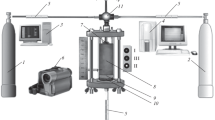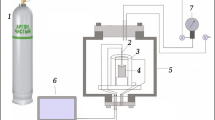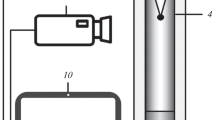Abstract—
We have studied the phase composition and structure of titanium carbide with a nickel binder prepared by self-propagating high-temperature synthesis in a cocurrent inert or reactive gas stream using granulated mixtures containing different grades of titanium. The results demonstrate that, unlike in the case of powder mixtures with a loose bulk density, the products of combustion of a granulated Ti + C + 25% Ni mixture in flowing nitrogen or without it retain their structure and granule size and can readily be ground into powder. In the case of the powder mixture both in a flowing gas and without it and in the case of the granulated mixture in flowing argon, the combustion products have the form of unbreakable sinter cakes, independent of the grade of titanium. Microstructural analysis of the combustion products points to spontaneous dispersion of the titanium particles surrounded by the nickel binder, independent of the starting mixture (granules or powder with a loose bulk density). Moreover, the phase composition of the synthesis products depends on the size and morphology of the titanium particles. In the case of PTM titanium, the final synthesis product consists of titanium carbide and nickel phases. After the combustion of mixtures based on PTM-1 titanium powder or a 50% PTM + 50% PTM-1 mixture, the final product consists of TiC, Ni, and TixNiy intermetallic phases. Synthesis in flowing nitrogen has been shown to change the phase composition of the combustion products of the mixtures based on PTM-1 titanium powder and a 50% PTM + 50% PTM-1 mixture, causing the intermetallic phases to disappear. To account for the combustion behavior of the mixtures, we have proposed a two-step mechanism of interaction in the Ti + C + 25% Ni system.








Similar content being viewed by others
REFERENCES
Kiparisov, S.S., Levinskii, Yu.V., and Petrov, A.P., Karbid titana: poluchenie, svoistva, primenenie (Titanium Carbide: Preparation, Properties, and Application), Moscow: Metallurgiya, 1987.
Zhang, X.-H., Han, J.-C., He, X.-D., and Kvanin, V.L., Combustion synthesis and thermal stress analysis of TiC–Ni functionally graded materials, J. Mater. Synth. Process., 2000, vol. 8, no. 1, pp. 29–34. https://doi.org/10.1023/A:1009469610918
Khimicheskaya tekhnologiya keramiki. Uchebnoe posobie dlya vuzov (Chemical Technology of Ceramics: A Learning Guide for Higher Education Institutions), Guzman, I.Ya.,Ed., Moscow: Stroimaterialy, 2003.
Merzhanov, A.G. and Mukas’yan, A.S., Tverdoplamennoe gorenie (Solid Flame Combustion), Moscow: Torus, 2007.
Seplyarskii, B.S., Kochetkov, R.A., and Vadchenko, S.G., Burning of the Ti + xC (1 > x > 0.5) powder and granulated mixtures, Combustion, Explosion Shock Waves, 2016, vol. 52, no. 6, pp. 665–672. https://doi.org/10.1134/S001050821606006X
Dunmead, S.D., Readey, D.W., Semler, C.E., and Hol, J.B., Kinetics of combustion synthesis in the Ti–C and Ti–C–Ni systems, J. Am. Ceram. Soc., 1989, vol. 72, no. 12, pp. 2318–2324. https://doi.org/10.1111/j.11512916.1989.tb06083.x
Rogachev, A.S., Shkiro, V.M., Chausskaya, I.D., and Shvetsov, M.V., Gasless combustion in the system titanium–carbon–nickel, Combustion, Explosion Shock Waves, 1988, vol. 24, no. 6, pp. 720–726. https://doi.org/10.1007/BF00740417
Kochetov, N.A., Rogachev, A.S., and Pogozhev, Yu.S., The effect of mechanical activation of a reaction mixture on the velocity of the wave propagation of SHS reactions and microstructure of the TiC–Ni hard alloy, Russ. J. Non-Ferrous Met., 2010, vol. 51, no. 2, pp. 177–181.
Seplyarskii, B.S., The nature of the anomalous dependence of the velocity of combustion of “gasless” systems on the sample diameter, Dokl. Phys. Chem., 2004, vol. 396, nos. 4–6, pp. 130–133. https://doi.org/10.1023/B:DOPC.0000033505.34075.0a
Seplyarskii, B.S., Tarasov, A.G., and Kochetkov, R.A., Experimental study of the combustion of a “gasless” granulated Ti + 0.5C composition in cocurrent streams of argon and nitrogen, Fiz. Goreniya Vzryva, 2013, no. 5, pp. 55–63.
Itin, V.I., Monasevich, T.V., and Bratchikov, A.D., Effect of mechanical activation on general relationships of self-propagating high-temperature synthesis in the titanium–nickel system, Fiz. Goreniya Vzryva, 1997, no. 5, pp. 48–51.
Seplyarskii, B.S. and Kochetkov, R.A., Combustion behavior of Ti + xC (x > 0.5) powders and granules in a cocurrent gas stream, Khim. Fiz., 2017, vol. 36, no. 9, pp. 21–31.
Seplyarskii, B.S., Tarasov, A.G., Kochetkov, R.A., and Kovalev, I.D., Combustion behavior of Ti + TiC mixtures in a cocurrent nitrogen stream, Fiz. Goreniya Vzryva, 2014, no. 3, pp. 61–67.
Author information
Authors and Affiliations
Corresponding author
Rights and permissions
About this article
Cite this article
Seplyarskii, B.S., Kochetkov, R.A., Lisina, T.G. et al. Phase Composition and Structure of Titanium Carbide/Nickel Binder Synthesis Products. Inorg Mater 55, 1104–1110 (2019). https://doi.org/10.1134/S0020168519110116
Received:
Revised:
Accepted:
Published:
Issue Date:
DOI: https://doi.org/10.1134/S0020168519110116




